
The Touro Synagogue or Congregation Jeshuat Israel is a synagogue built in 1763 in Newport, Rhode Island. It is the oldest synagogue building still standing in the United States, the only surviving synagogue building in the U.S. dating to the colonial era, and the oldest surviving Jewish synagogue building in North America. In 1946, it was declared a National Historic Site.

Joseph Gilbert Totten fought in the War of 1812, served as Chief of Engineers and was regent of the Smithsonian Institution and cofounder of the National Academy of Sciences. In 1836, he was elected a member of the American Philosophical Society.

Malbone is one of the oldest mansions in Newport, Rhode Island. The original mid-18th century estate was the country residence of Col. Godfrey Malbone of Virginia and Connecticut. The main house burned down during a dinner party in 1766 and the remaining structure sat dormant for many years until New York lawyer Jonathan Prescott Hall built a new roughly 5,800 sq ft (540 m2) castellated residence directly on top of the old ivy-covered ruins.

Fort Adams is a former United States Army post in Newport, Rhode Island that was established on July 4, 1799 as a First System coastal fortification, named for President John Adams who was in office at the time. Its first commander was Captain John Henry who was later instrumental in starting the War of 1812. The current Fort Adams was built 1824–57 under the Third System of coastal forts; it is part of Fort Adams State Park today.

Hunter House (1748) is a historic house in Newport, Rhode Island. It is located at 54 Washington Street in the Easton's Point neighborhood, near the northern end of the Newport Historic District.
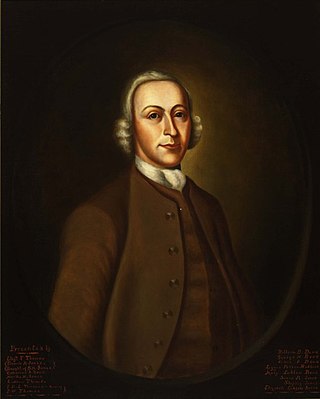
Peter Harrison was a colonial American architect in New England who is credited with bringing the Palladian architectural movement to the colonies.

The Museum of Newport History is a history museum in the Old Brick Market building in the heart of Newport, Rhode Island, United States. It is owned and operated by the Newport Historical Society at 127 Thames Street on Washington Square. The building, designed by noted 18th-century American architect Peter Harrison and built in the 1760s, is a National Historic Landmark.
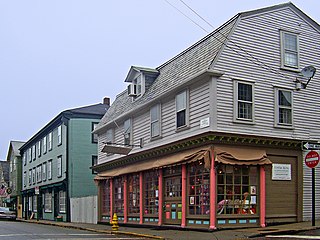
The Newport Historic District is a historic district that covers 250 acres in the center of Newport in the U.S. state of Rhode Island. It was designated a National Historic Landmark (NHL) in 1968 due to its extensive and well-preserved assortment of intact colonial buildings dating from the early and mid-18th century. Six of those buildings are themselves NHLs in their own right, including the city's oldest house and the former meeting place of the colonial and state legislatures. Newer and modern buildings coexist with the historic structures.

The Newport Artillery Company of Newport, Rhode Island was chartered in 1741 by the Rhode Island General Assembly during the reign of King George II of Great Britain. It is the oldest military unit in the United States operating under its original charter, and the company maintains a museum in its historic armory. The company has served in wars ranging from the French and Indian War to the First World War. Individual members of the Company have served in every war fought by the United States.
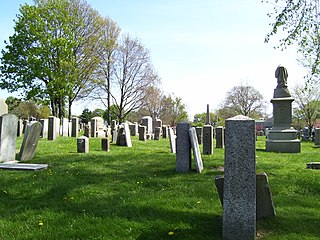
The Common Burying Ground and Island Cemetery are a pair of separate cemeteries on Farewell and Warner Street in Newport, Rhode Island. Together they contain over 5,000 graves, including a colonial-era slave cemetery and Jewish graves. The pair of cemeteries was added to the National Register of Historic Places as a single listing in 1974.
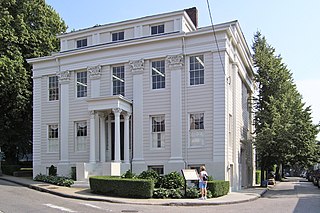
The Levi H. Gale House is a historic house at 85 Touro Street in Newport, Rhode Island, United States.

The Kay Street–Catherine Street–Old Beach Road Historic District is a historic district in Newport, Rhode Island. The area is located north of Newport's well-known Bellevue Avenue, and encompasses an area that was developed residentially between about 1830 and 1890, for the most part before the Gilded Age mansions were built further south. The district is bounded on the south by Memorial Boulevard, on the east by Easton's Pond, on the west by Bellevue Avenue and Kay and Bull Streets, and on the north by Broadway, Rhode Island Avenue, Prairie Avenue, and Champlin Street. The district was added to the National Register of Historic Places on May 22, 1973, with a boundary decrease in 2018.
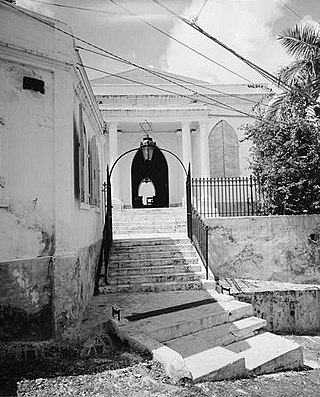
St. Thomas Synagogue is a historic synagogue at 2116 Crystal Gade, Queens Quarters, in Charlotte Amalie on the island of Saint Thomas in the U.S. Virgin Islands. The formal name of the synagogue is Congregation Beracha Veshalom Vegmiluth Hasadim. It was declared a National Historic Landmark in 1997.

Chepstow is an Italianate house museum located at 120 Narragansett Avenue in Newport, Rhode Island, built in 1860. It originally served as a summer "cottage", but the Preservation Society of Newport County now owns the property. It was listed in the National Register of Historic Places as part of the Ochre Point-Cliffs Historic District in 1975 and within the Historic District of the City of Newport.
Chestnut Hill is an 18th-century Federal-style mansion north of Leesburg in Loudoun County, Virginia, United States. Chestnut Hill was a home of Thomson Francis Mason, a prominent jurist, lawyer, councilman, judge, mayor of Alexandria, and grandson of Founding Father of the United States George Mason. Chestnut Hill was also a home of Mason's son, Dr. John "Frank" Francis Mason. It is located at 13263 Chestnut Hill Lane near Leesburg.

Thames Street is a historic street in Newport, Rhode Island that is one of the oldest continuously used streets in the state. It remains the primary street in downtown Newport and runs parallel along the waterfront.
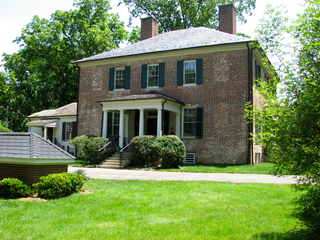
Fall Hill is a plantation located near the falls on the Rappahannock River in Fredericksburg, Virginia. Though the Thornton family has lived at Fall Hill since the early 18th century, the present house was built in 1790 for Francis Thornton V (1760–1836). The land on which Fall Hill is located is part of an 8,000 acres (3,200 ha) land patent obtained by Francis Thornton I (1657–1727) around 1720. The present-day town of Fredericksburg, Virginia is located on that original patent.
Timeline of Newport, Rhode Island.
Thomas Breese was an American naval officer. Best known for his service under Oliver Hazard Perry during the 1813 Battle of Lake Erie, he served in the United States Navy for another 33 years, including as a paymaster for over two decades.

Dudley Newton (1845-1907) was an American architect from Newport, Rhode Island.




















